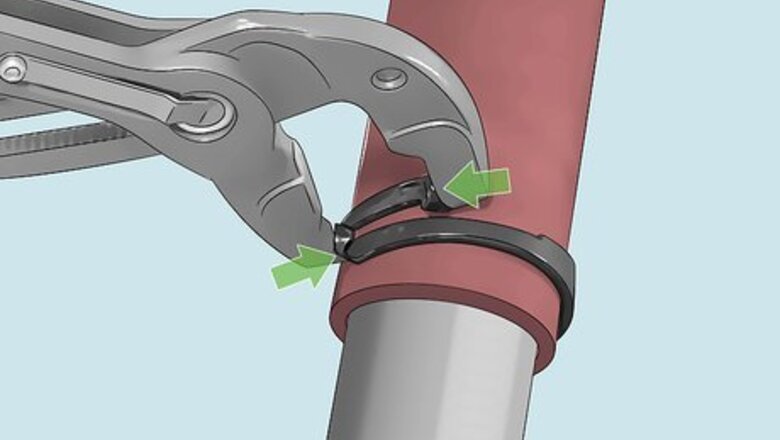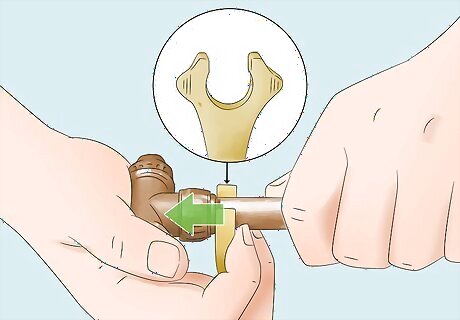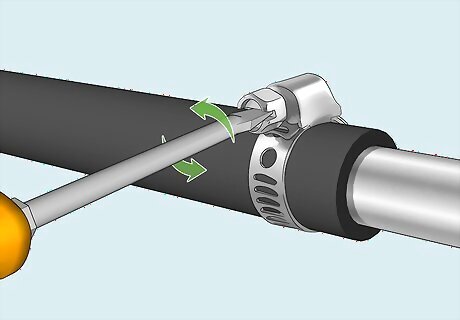
views
How do you remove a spring hose clamp?

Using a pair of hose clamp pliers. Open up the jaws of the pliers and hook the teeth into the slots on the 2 protruding arms of the spring hose clamp. Squeeze the handles of the pliers to pinch and loosen the clamp, then slide the clamp off the hose. Spring hose clamps look like a metal ring with a slot running down the middle and 2 protruding arms that stick up from the ring, which you squeeze to loosen the clamp. You might find a spring hose clamp on a rubber cooling system hose in an automobile, for example. Get a pair of flexible hose clamp pliers, so you can use them to remove a variety of different sizes of hose clamps. They’re available online for under $20 USD.
How do you remove a pinch clamp?

Snip it off with a set of bullnose or side cutters. Open up the jaws of your cutters and place them over the ear of the clamp, or the metal part that’s projecting up from the ring. Squeeze the cutters firmly together to snip the ear off, then pull the ring off the hose. Pinch hose clamps look like a metal ring with square-shaped holes in them and a protruding metal ear, which creates tension on the tubing when crimped. Alternatively, cut through the hose clamp using a rotary tool fitted with a cutting blade. Pinch clamps are also known as crimp clamps or one-time-use hose clamps.
How do you remove a SharkBite clamp?

Slide it off with a SharkBite disconnect clip. Choose the appropriate disconnect clip for the diameter in millimeters of the tubing you want to remove a SharkBite clamp from. Snap the clip onto the tubing, just above the clamp, then press the clip against the clamp’s disconnecting ring while you pull the tubing in the opposite direction. SharkBite hose clamps are just brass push-to-fit plumbing fittings that have an interior plastic component, which fits inside the tubing. They are commonly found in all types of plumbing applications. SharkBite fittings are sometimes used on PEX tubing because other types of hose clamps don’t work for PEX. The disconnecting ring is just another moveable ring inside the fixed, exterior metal ring of the SharkBite hose clamp. For 35-mm to 55-mm SharkBite clamps, you have to rotate the disconnecting clip clockwise to disengage the clamp.
How do you unscrew a screw hose clamp?

Loosen the bolt with a flat-head screwdriver or a socket wrench. Screw hose clamps have both a screwdriver slot and a bolt head, so either tool works. Turn the bolt counterclockwise using your selected tool until it’s loose, then pull it off the tubing to remove it. Screw hose clamps look like metal rings with slots in them and have a screw with a bolt head on one side, which is what you use to tighten or loosen the clamps. Alternatively, use a power drill fitted with a flat-head drill bit or a wrench drill bit to unscrew the hose clamp. Screw hose clamps are also known as T-bolt hose clamps.
How do you remove a washing machine hose clamp?

Pull it off using a pair of channel lock pliers. Grasp the protruding arms of the hose clamp between the jaws of the pliers and squeeze tightly to disengage it. Pull the hose off the back of the washing machine while still squeezing the pliers to disconnect it. Slide the hose clamp off the end of the drain hose. You would need to do this if the drain hose clamp on your washing machine is broken or rusted out, for example. Reverse the process with a new hose clamp to reconnect your washing machine’s drain hose. If you use a pipe, apply pipe joint compound on the exposed threads of the pipe. It is preferable to use a plumbing compound that contains Teflon. The advantage of using this compound is that Teflon expands when it gets wet and seals the leaks. Bob Vila Bob Vila, Home Improvement Specialist When tackling home repairs involving hoses, keep a set of hose clamp pliers on hand for quick removal. These specialized pliers allow you to easily detach spring, pinch, and washing machine style clamps without damage. Simply grip the protruding arms or edges and squeeze to loosen the clamp. For extra leverage, lock the pliers in place with the built-in catch before pulling the hose free.




















Comments
0 comment